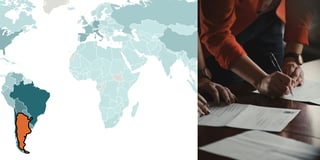Where houseplants really come from
Hi there! I’m Margaux, from the support team, and this week I’m on Weekly Chart duty.
A couple months ago, I listed and analyzed the contents of my closet for a Weekly Chart, asking myself, among other things: Where were those clothes made? Well, clothing isn’t the only thing in our households that comes from afar. This week I decided to go down the “datavis of self” road again, and to ask myself this time: Where do my houseplants come from?
There are about thirty plants in my apartment, mostly taken care of by my partner (save for a few daisies on the balcony that have seen better days). Although these plants were very likely bred far from their homeland for decorative purposes, or come from gifted cuttings or seeds, most of them — except a few man-made hybrids — have their origin in nature. Yes, you read that right, that giant yellowish Monstera crying for help in a corner of your living room did have ancestors deep in the South American rainforest. Crazy, I know.
Most of the plants that are owned in Europe today don’t actually come from Europe. So without further ado, where do my plants come from?
Houseplants, you might think, started to be a thing when European “explorers” started to bring back exotic plants from faraway lands. Looking at this map, we can clearly see the role colonization has had in the practice of indoor gardening in Europe, with most of them coming from territories that used to be colonies.
While the habit of keeping houseplants did grow from the 17th century on, when orangeries were all the rage in European elite society, historians have traced potted plants to as early as Sumer and ancient Egypt, 4,000 years ago. The Greeks and Romans also had indoor houseplants. While the practice dwindled in the Middle Ages, it was rekindled during the Renaissance, when Europe started its large-scale colonization and merchants and plant collectors started to import plants to Europe.
From the plants that grow in my apartment, the only species native to Europe are aromatics and lavender (and even then, they are definitely not native to Germany). Even daisies, which I sort of assumed had always grown on the European continent, are actually natives of South Africa.
I think it’s fascinating to see how plants can thrive so far away from their natural habitat. In a way, I guess you could say as humans we share much more with plants than we would think. They adapt to a variety of habitats, from the lushest forests to a terracotta pot in your front garden. They need care, attention, and neither too much nor too little water, just like us. And one plant secret everyone seems to agree on, from my grandmother to my green-thumbed partner to the various plant blogs run by nature-thirsty millennials, is to talk to your plants. While this might sound like a bit of an eccentric thing to do, research has actually backed it up. Plants respond to vibrations, specifically low levels of vibration, which can “improve communication and photosynthesis, which improves growth and the ability to fight infection.” Charles Darwin himself mentioned the effect of vibration on plants in a 1880 book, as related in this article (from which I understand, um, some words). So in a nutshell, just like us, plants also need companionship and communication.
Caring for plants has a lot of benefits — it calms you, gives a sense of purpose and responsibility. I don’t exactly do the caring myself, so you could say the benefits are lost on me, but after writing about them for a few days I might get into it! And if not, well, I’ll just enjoy the purer air and greenery they bring into my living room.
That’s it for today! Next week, Lisa is back with a Weekly Chart. And me, I’m home alone on plant duty this week, so I’ll tend to that now. See you next time!



